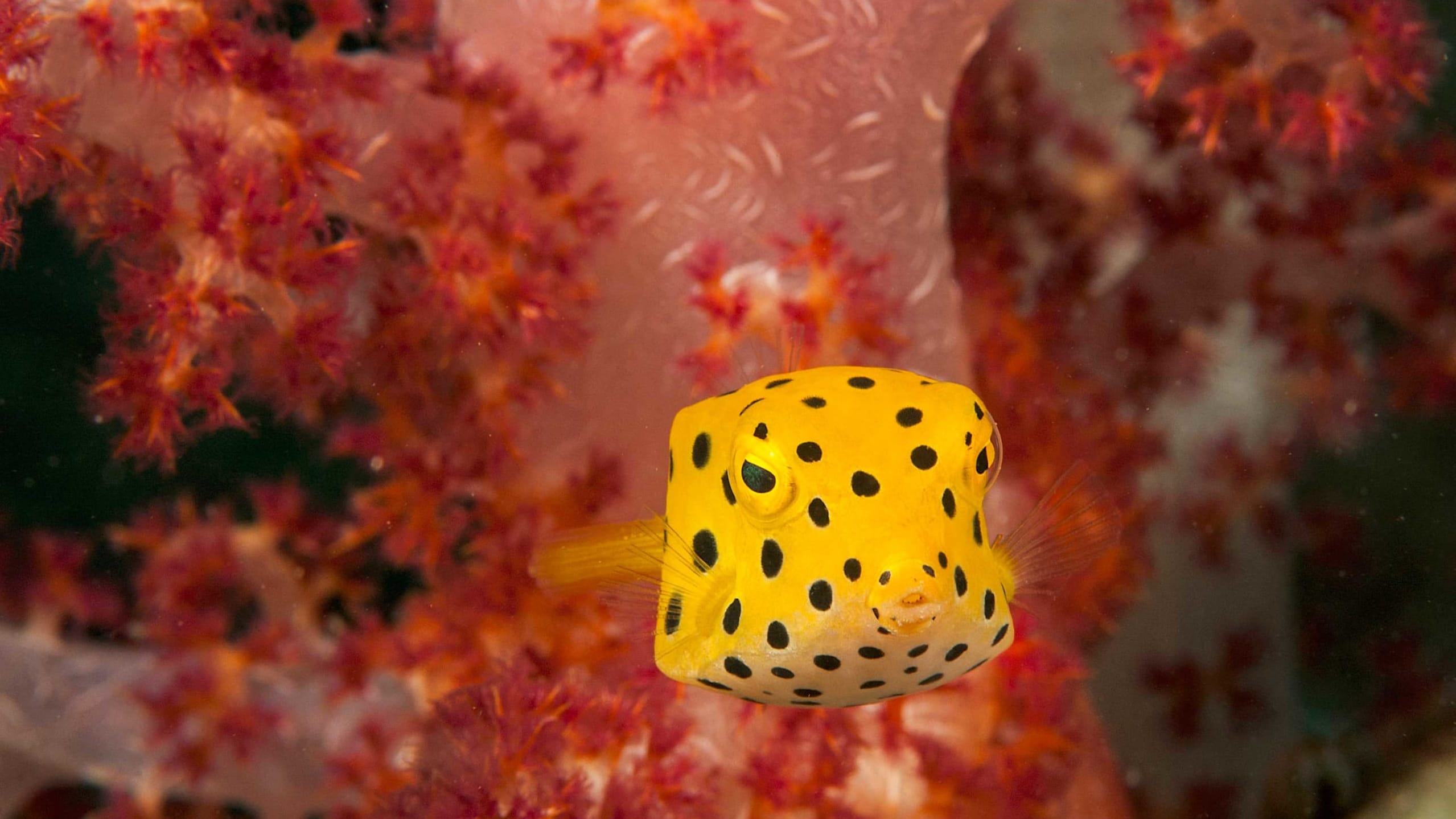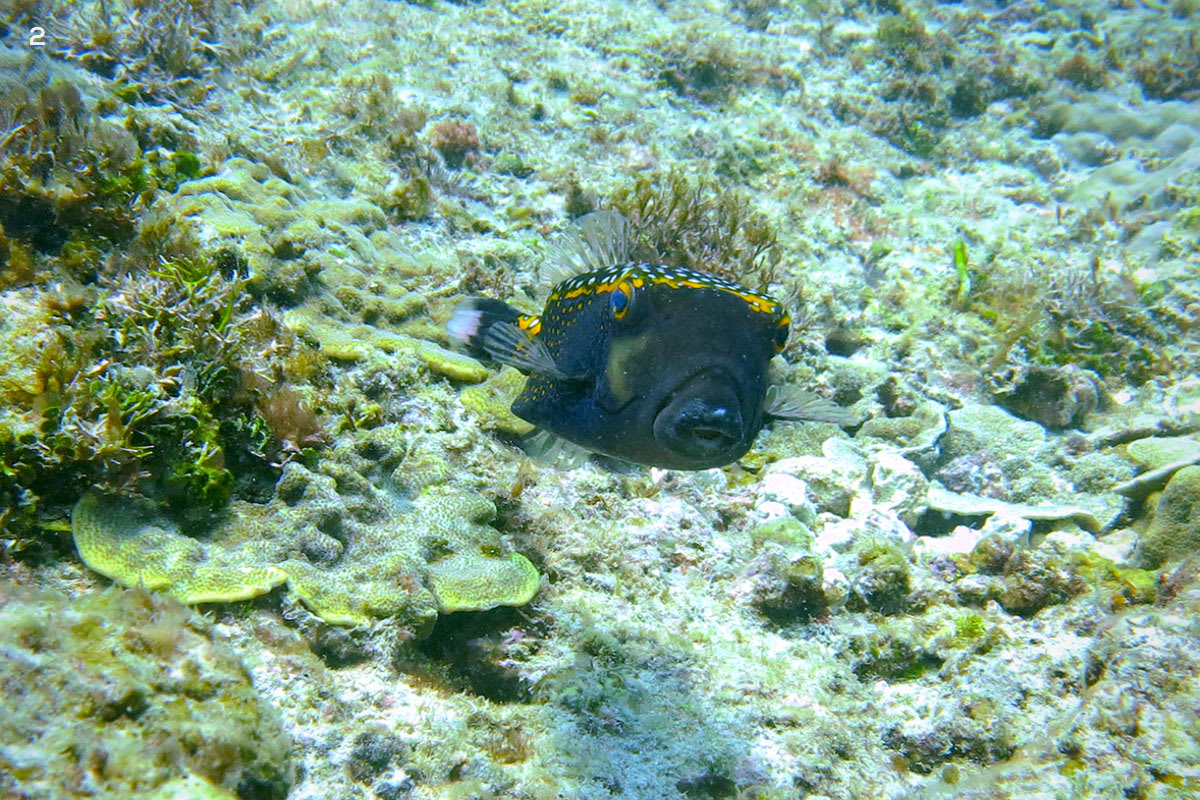 Listen to this article
•
15:34 min
Listen to this article
•
15:34 min
A yellow boxfish looks like a pocket-sized burglar on the run, having been caught red-handed stealing a box that it has swallowed whole to facilitate a quick escape from the crime scene. While this makes a good scenario for a fictional story of how boxfishes got their shape, the science behind their peculiar appearance and way of life is stranger than fiction.
I always thought of boxfish (family Ostraciidae) as cute and goofy, with the wobbliest swimming style of any fish I had seen. Little did I realise that boxfish are more than adorable polka-dotted faces. They are armoured fish packed with lethal poisons. And for decades, these fish have been the subject of research in fields as wide and seemingly unrelated as biochemistry and automobile design.
The easiest way to look up boxfishes in the Reef Fish Identification Guide by Allen et al., is to find the section dedicated to “odd-shaped swimmers”. Other odd-shaped fish found on reefs include flounders, flatheads, trumpetfishes, mola-molas and many others that look far from the textbook fish shapes we know so well. Amidst the geometric diversity that many reef fish bring to the table (the nearly spherical puffers, laterally flattened filefish and rhombus-shaped triggerfish), the 23 odd boxfish species stand out for their distinct squares, rectangles, pentagons, and triangles.
A rigid encasing made of dermal bone is what lends these fish their various shapes. Thought to have evolved as a defence measure against bites from predators, boxfish have evolved an extremely hard carapace (bony shell). This carapace is a result of numerous hexagonal plates sutured together. Keeping with our cartoon image of the thieving boxfish that swallowed a box, all its vital organs are kept protected inside the box, with just enough room on the outside for a tail, fins, and a small pouting mouth.
Boxfish are solitary fish that live in warm and shallow habitats, typically coral reefs and seagrass meadows. Being omnivores, their diet includes a regular grazing of algae — which they pinch off in small bites with their narrow mouths. They complement their herbivorous diet with various sessile organisms like sponges, worms, and other small invertebrates that they find in the rocks or hidden in the sand. Boxfish often spit jets of water into the sandy floor to reveal hidden invertebrates.
To truly understand what may have led to the curious evolution of boxfish, it helps to view their ecology from a more interdisciplinary lens, where the physical and mechanical meet the chemical and mathematical. The use of chemicals is a common strategy for predator defence in the animal world, both above and below water. Unpalatable butterflies and toxic sea slugs are excellent examples of how effective chemical defence can be. Each of these poisonous animals goes about their day at a leisurely pace, with slow flutters and sluggish crawls, not having to constantly hide or worry about needing to camouflage. And then we have the boxfish, who appear to have taken this evolutionary formula for defence to the next level.
A threatened and distressed boxfish exudes from its skin a mucous-like toxic cocktail containing what are called “pahutoxins”. Pahutoxins when released into the water, cause irritability at first, and then due to their surfactant (surface-active) properties, immediately foam up the water, binding especially to the gills of nearby fish. The toxins begin asphyxiating the fish, rupturing their red blood cells, causing convulsions and eventually death. This extreme defence measure is considered protection against predators like sharks and groupers but will invariably affect any gilled animals that find themselves in waters with as low of a toxin concentration as ten parts per million. Just when we might think this is quite excessive as a defence measure, we are reminded of the ultra-rigid multi-dimensional bony box that also protects all the boxfish’s vital organs.
One would imagine that being any kind of polygon shape would be disadvantageous in a watery world where most fish seem to aim for streamlining. The body design of boxfishes does seem unwieldy and unstable at first. With their small fins doing all the swimming, boxfish can reach burst speeds of about six body lengths per second (for perspective some tuna can move at up to 14 body lengths per second). So, what forces may have led to the boxfish being built this way? While fully grown adult boxfishes have a fully loaded arsenal of defences against predators, they are still vulnerable as juveniles (imagine a five-centimetre box with fins swimming around a predator rich reef).
New research exploring fluid dynamics and biomechanics has found that perhaps it may never have been about stability and speed for the boxfish. In fact, boxfish seem to take advantage of their instability, coupling this with tail fins that function as course-stabilising rudders, allowing them to do what most fish can only dream of. Boxfish can make sharp turns in any direction while hovering in the same spot, and they can swim sideways, diagonally and upside down.
With so many safety measures packed into their boxy bodies, these fish can attempt something quite incredible. During their breeding seasons, male white-spotted boxfish form small harems within their territories. Every evening, together with prospective mates, they leave the safety of their sheltered habitats and swim hundreds of metres into the big blue, where numerous predators await. Here pairs of boxfish will spawn, females releasing eggs and males their sperm offshore in the hope of successfully dispersing their offspring. They return to their reefs after spawning, only to ascend again the following day.
Observing a boxfish will never be the same again. What earlier looked like a small helpless fish struggling to swim will now look like a scene out of “The Beautiful Mind”, a genius fish that calculates the flowrate of water over its carapace, to estimate how it will counter every pitch and yaw. Learning about these extraordinary fish has been a timely reminder that every stream of science is embedded in how nature functions, and that’s what makes unravelling its mysteries so fascinating. To all young aspiring biologists out there, embrace mathematics!














